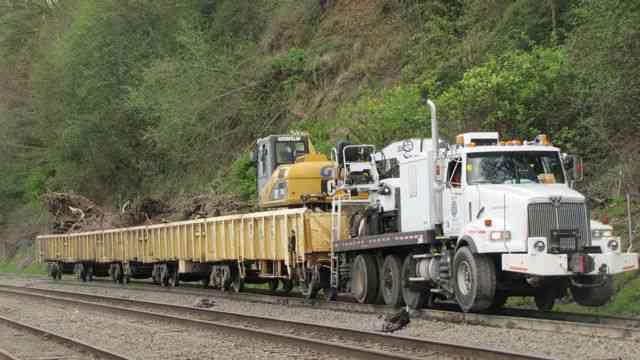Landslides more prevalent in Pacific Northwest as climate change indicates rain increase
Crews from BNSF Railway clear away debris after a recent landslide shut down rail traffic near Everett, Wash. (Photo by Ashley Ahearn/EarthFix.)
Editor’s Note: This story comes by way of EarthFix.
Climate change experts predict an increase in precipitation in the the U.S. Pacific Northwest, which could mean more landslides in the region’s future.
Much of the Pacific Northwest was once a large temperate rainforest, and there is still plenty of rain around. But that could get even worse.
One consequence may well be more mudslides. A spectacular slide recently took out a home and threatened dozens of others on an exclusive island in Puget Sound.
But less dramatic and far more regular slides are now plaguing passenger and freight rail service. Over the past winter, BNSF, the Burlington Northern Santa Fe Railway has had 200 landslides on or near its tracks — making it one of the worst seasons since the company began keeping records in 1914.
Every day about 40 trains full of freight or passengers travel these tracks, en route from Seattle and points south toward Canada. But on one particular recent day, you wouldn’t hear approaching trains, just some sea lions bantering offshore and some men in orange vests operating heavy machinery.
Gus Melonas, a BNSF spokesman, stands nearby as a massive dumptruck rolls past with a massive collection of tree roots and mounds of earth.
“This would rate right at the top — definitely top five as far as slide after slide,” he said. “Ssome feel top three.”
Landslides are caused by a lot of different things: increases in housing development on bluffs, changes in vegetation. But ultimately, says Jonathan Godt, a scientist with the U.S. Geological Survey, landslides are caused simply by gravity.
“You’ve got a steep slope and gravity wants to pull everything down and then when water infiltrates into the soil it changes the stress of the soil,” he said.
That’s right, water stresses out soil. It pushes the particles apart, weakening the composition of say, a bluff overlooking Puget Sound, and making the soil heavier with moisture.
Climate change experts predict that in the Northwest we could see more precipitation overall, with heavier downpours and storm events. In Washington, the average annual precipitation has increased by about a third of an inch each decade since the beginning of the 20th century.
And this winter saw above average rainfall in the north Puget Sound. That’s where BNSF says 95 percent of its landslide problems have occurred.
Lara Whitely-Binder, with the Climate Impacts Group at the University of Washington, says this has become a major issue in the region — and one with clear climate change undertones.
Whitely-Binder says while you can loosely tie individual rain events to mudslides, there’s no way to prove climate change is to blame for this year’s bout of landslides.
Landslides are nothing new for the Northwest. BNSF Railway has documented 900 slides on their tracks in the past 100 years. But Whitely-Binder says in the future there could be more wet winters like this past one.
“We are expecting to see more winter precipitation and more intense precipitation events, so we would anticipate seeing a greater risk of landslides moving forward in time,” she said.
Carol Lee Roalkvam heads environmental policy at the Washington State Department of Transportation and co-authored an assessment of the department’s vulnerability to climate change.
“We’re aware now of more upriver flooding than we’ve seen in the past, more extreme rain events – the sudden and intense rain that we’ve been experiencing more frequently,” Roalkvam said. “So a lot of the state routes are vulnerable to landslides today and the projections are that those will be worse.”
But Roalkvam is confident in the department’s plans for responding to climate change.
“I don’t think anyone can design themselves away from every single risk but I think we have a lot going for us here,” she said.
Melonas, from BNSF, agrees.
“We’ve made appropriate drainage, ditching, we’ve put up catchment walls, we’ve put up retaining walls, slide detection fences, the marine wall along Puget Sound, we’ve beefed it up,” he said.
All of which costs money. Money that will likely have to be spent in greater numbers if climate changes does in fact lead to more rain across the region.
We want to hear your feedback so we can keep improving our website, theworld.org. Please fill out this quick survey and let us know your thoughts (your answers will be anonymous). Thanks for your time!
